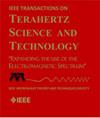Micromachined High Gain Diagonal Horn Array Antenna With Suppressed Grating Lobes for 190 GHz-250 GHz
IF 3.9
2区 工程技术
Q2 ENGINEERING, ELECTRICAL & ELECTRONIC
IEEE Transactions on Terahertz Science and Technology
Pub Date : 2025-01-30
DOI:10.1109/TTHZ.2025.3536329
引用次数: 0
Abstract
This article presents a high gain, broadband silicon micromachined diagonal horn array antenna for the 190 to 250 GHz frequency band. The antenna array is configured to be built from 34 silicon layers. The upper 25 layers of silicon wafers create an 8 × 8 diagonal horn array antenna and the lower 9 layers form the feed network. The diagonal horn is selected as a radiation element for its 45° polarization direction, which suppresses side and grating lobes in the190 GHz-250 GHz抑制光栅瓣的微机械高增益对角喇叭阵列天线
本文提出了一种用于190 ~ 250 GHz频段的高增益、宽带硅微机械对角喇叭阵列天线。天线阵列被配置为由34个硅层组成。上面的25层硅片形成一个8 × 8的对角喇叭阵列天线,下面的9层形成馈电网络。选择对角喇叭作为45°极化方向的辐射单元,在阵列形成后抑制e面和h面侧瓣和光栅瓣。在馈电网络中创新性地采用了极化变换器来解决波导t型结的反极化问题。为了满足硅微加工要求,根据硅片厚度设计了所有斜角和进给网络的步进轮廓。34个硅层是通过计算机数控铣削金属刀具对准和固定的。利用蒙特卡罗分析对晶圆组装过程中引入的层间偏移误差进行了量化。测量结果在误差允许范围内。该天线的峰值增益为30.9 dBi,工作频率带宽为27%。该天线在e平面和h平面具有高度定向的低旁瓣水平辐射,非常适合下一代太赫兹点对点通信系统。
本文章由计算机程序翻译,如有差异,请以英文原文为准。
求助全文
约1分钟内获得全文
求助全文
来源期刊

IEEE Transactions on Terahertz Science and Technology
ENGINEERING, ELECTRICAL & ELECTRONIC-OPTICS
CiteScore
7.10
自引率
9.40%
发文量
102
期刊介绍:
IEEE Transactions on Terahertz Science and Technology focuses on original research on Terahertz theory, techniques, and applications as they relate to components, devices, circuits, and systems involving the generation, transmission, and detection of Terahertz waves.
 求助内容:
求助内容: 应助结果提醒方式:
应助结果提醒方式:


